Kenneth C. Davis's Blog, page 29
June 29, 2021
Whatever Became of 56 Signers (Part 10 of 11)
(Post revised 6/29/2021)
Part 10 of a blog series profiling the 56 men who signed the Declaration of Independence. The series begins here. The previous posts can be found in the website Blog category.
As the nation examines the role slavery played in its history, it is important to recognize that slavery was an issue in 1776. Among the men who signed the Declaration, at least forty of them enslaved people or took part in the slave trade. A “YES” following the entry means the Signer enslaved people; “No” means he did not.
…We mutually pledge to each other our Lives, our Fortunes , and our Sacred Honor.
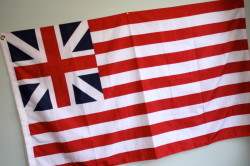
The Grand Flag of the Union, first raised in 1775 and by George Washington in early 1776 in Boston. The Stars and Stripes did not become the “American flag” until June 14, 1777. (Author photo © Kenneth C. Davis)
A victim of the British. Two Irish immigrants, one an indentured servant. A reluctant lawyer. An orphaned carpenter. Among the next five of 56 signers.
–Richard Stockton (New Jersey) Of the signers who paid for their actions, this successful and much-admired 45-year-old attorney at the signing, may have suffered most. Betrayed by Tory Loyalists in his home state, he was captured by the British in 1776, although later released in a prisoner exchange, not for having sworn allegiance to the King, as reported in a much-disputed rumor of the day. His New Jersey home was also damaged by the British but later restored. Stockton was in poor health after the experience in captivity but lived until 1781, when he died of throat cancer.
Stockton is also credited with recruiting John Witherspoon, an influential Sottish minister, (See next installment in series) to become president of the College of New Jersey (later Princeton). His daughter, Julia, was married to Benjamin Rush, another signer.
“Stockton’s home ‘Morven’ had been occupied by British General Cornwallis. Dr. Benjamin Rush wrote: ‘The whole of Mr. Stockton’s furniture, apparel, and even valuable writings have been burnt. All his cattle, horses, hogs, sheep, grain and forage have been carried away by them. His losses cannot amount to less than five thousand pounds.’” (Source: The Society of the Descendants of the Signers.)
His home Morven, later served as the New Jersey Governor’s Mansion from 1954-1981. Today, his name is familiar to most people because there is rest stop on the New Jersey Turnpike named in his honor. YES
–Thomas Stone (Maryland) Among the conservatives in Congress, he was a 33-year-old attorney at the signing, reluctant about independence, but then joining in the favorable vote.He wrote:
“I wish to conduct affairs so that a just and honorable reconciliation should take place, or that we should be pretty unanimous in a resolution to fight it out for independence. The proper way to effect this is not to move too quick. But then we must take care to do everything which is necessary for our security and defense, not suffer ourselves to be lulled or wheedled by any deceptions, declarations or givings out. You know my heart wishes for peace upon terms of security and justice to America. But war, anything, is preferable to a surrender of our rights.” (Source: The Society of the Descendants of the Signers)
Another son of a wealthy planter, he had a low profile after the signing, helping write the Articles of Confederation but not signing them. He also declined to take part in the Constitutional Convention, when his wife, who fell ill following an earlier inoculation against smallpox, died in 1787. Apparently despondent, he died four months later in 1787 at age 44. YES
–George Taylor (Pennsylvania) Arriving in America as an indentured servant from Ireland, he was a 60-year-old merchant and iron maker at the signing. He had risen at the foundry where he worked to become bookkeeper, then bought the business after his employer’s death and then married the late owner’s widow. Taylor was not in the influential Pennsylvania delegation for the July vote, but signed the document in August. During the war, his foundry provided cannon and cannonballs for the war effort, but Congress was notoriously slow to pay its bills and his business suffered. He died in 1781 at age 65. YES
–Matthew Thornton (New Hampshire) An Irish-born physician, he was around 62 at the signing, a veteran surgeon who had served with the New Hampshire militia in the French and Indian War. A latecomer to Congress, he joined in November 1776 and was later permitted to add his name to the document. He later served as a state judge and then operated a farm and ferry before his death in 1803 at about age 89. NO
–George Walton (Georgia) Orphaned and apprenticed as a carpenter, he was a 35-year-old, self taught attorney at the signing. Although his exact birth date is unknown, some claim that he was the youngest Signer – a distinction usually given to Edward Rutledge (See previous entry).
Serving with the Georgia militia, he was shot and captured by the British in 1778. He was held for a year before being exchanged for a British officer –even though it was known he was a Signer. He later served in a variety of state offices, including governor and senator from Georgia, and built a home on lands confiscated after the war from a Tory, or Loyalist. He is implicated in the events that led to the duel that killed fellow signer and political rival Button Gwinnet (see Part 3 of series). He died in February 1804, presumably aged 63 . NO
. NO
Update 6/29/2021:
“Unlike most men of property and influence in Georgia, Walton did not own slaves. There is little record of his public views on slavery, but it is known that shortly after leaving the governor’s mansion, Walton spoke out against what he called ‘barbarian’ treatment of members of an African-American Baptist congregation in Yamacraw, Georgia, in 1790.”

America’s Hidden History, includes tales of “Forgotten Founders”
June 28, 2021
Whatever Became of 56 Signers? (Part 9)
Post updated 6/28/2021]
Part 9 of a blog series profiling the 56 men who signed the Declaration of Independence. The series begins here. The complete series can be found in the website Blog category.
A “YES” following an entry means the Signer enslaved people; “NO” means he did not.
…We mutually pledge to each other our Lives, our Fortunes , and our Sacred Honor.

The Grand Flag of the Union, first raised in 1775 and by George Washington in early 1776 in Boston. The Stars and Stripes did not become the “American flag” until June 14, 1777. (Author photo © Kenneth C. Davis)
Betsy Ross’s uncle. The “first psychiatrist.” Youngest signer. The Great Compromiser. An Irishman named Smith. The next five signers:
–George Ross (Pennsylvania) The son of a Scottish-born minister, he was a 46-year-old attorney at the signing, a Loyalist or Tory, before turning to the Patriot cause in 1775. He served as a Colonel in the Pennsylvania militia. Yes, he was Betsy’s uncle by marriage, but the rest of the Ross flag story has been dismissed as family legend.
Ross left Congress in early 1777 due to illness — severe gout, a form of arthritis once described as the “rich man’s disease” that afflicted a number of other signers. He later served as a Pennsylvania judge before his death in 1779 at 49, following a severe attack of gout. NO

Dr Benjamin Rush by Charles Willson Peale c. 1783. Winterthur Museum
–Benjamin Rush (Pennsylvania) Raised by a widowed mother, he was a 30-year-old physician at the signing, youngest in the influential Pennsylvania delegation. He was elected after the July vote and his diaries, letters, and notes provided some of the best portraits of many of the signers and other founders.
He served as surgeon general of the armies during the war, and became an early abolitionist while still a slaveholder himself. Rush was also an early advocate of many modern medical practices, while at the same time practicing bloodletting. He established the first free medical clinic and remained in Philadelphia during a yellow fever epidemic in 1793 when the city was the nation’s capital, spoke against capital punishment, and in favor of the idea that there was mental illness which led to his being called “The Father of American Psychiatry.” He died of typhus in 1813 at age 67. YES
–Edward Rutledge (South Carolina) Son of an Irish immigrant physician, he was a 26-year-old attorney at the signing, the youngest of the signers. A wealthy planter as well as a much-admired attorney, Rutledge initially opposed the Declaration before changing his mind to support the favorable vote.
He later left Congress and was captured by the British while serving in the militia when Charleston fell in May 1780. He was held in St. Augustine for nearly a year. After the war, his finances and businesses flourished and he returned to state politics. Offered a Supreme Court seat by George Washington, he was instead elected governor of South Carolina in 1789, but died at age 50 in 1800, before his term ended. YES
–Roger Sherman (Connecticut) A self-educated son of a farmer, he was a prosperous merchant, attorney, and politician, aged 55 at the signing. He would sign three of the central documents in America’s foundation: the Declaration (he was a member of the draft committee), the Articles of Confederation, and the U.S. Constitution.
It was at the 1787 Constitutional convention that Sherman proposed the “Great Compromise” that ended the deadlock between large and small states. He was also a true “Founding Father”– after Carroll (18 children) and Ellery (16 children), Sherman fathered the third most children among the signers -15. A leading Federalist, he served in the House and Senate, where he was serving at his death in 1793 at age 72. NO
–James Smith (Pennsylvania) Another immigrant signer, he was born in Northern Ireland and was around 57-years-old at the signing, another self-taught attorney. He had been an outspoken advocate of challenging oppressive British laws and called for the boycott of British goods that was later adopted by the First Continental Congress.
He also joined the Pennsylvania militia and was elected an officer. After the July vote, he signed the Declaration and then rode to York, Pennsylvania to have it read aloud on July 6. He served as Brigadier General of the Pennsylvania militia and later returned to law practice and state offices before his death in 1806 at about age 87. NO

Now In paperback THE HIDDEN HISTORY OF AMERICA AT WAR: Untold Tales from Yorktown to Fallujah


America’s Hidden History, includes tales of “Forgotten Founders”
June 27, 2021
Whatever Became of 56 Signers? (Part 8)
[Updated 6/27/2021]
Part 8 of a blog series profiling the 56 men who signed the Declaration of Independence. The series begins here. The complete series can be found in the website Blog category.
A “YES” following an entry means the Signer enslaved people; “NO” means he did not.
…We mutually pledge to each other our Lives, our Fortunes , and our Sacred Honor.

The Grand Flag of the Union, first raised in 1775 and by George Washington in early 1776 in Boston. The Stars and Stripes did not become the “American flag” until June 14, 1777. (Author photo © Kenneth C. Davis)
Minister turned whaleboat captain and lawyer. Self-taught planters’ sons. A Nay vote. A rare bachelor. And a veiled man. The next six signers:
–Thomas Nelson, Jr. (Virginia) Another son of a wealthy planter. he was a 37-year-old merchant-planter at the signing, owner of more than 400 enslaved people. He raised money to supply troops and even commanded militia. Legend has it that he fired a cannon at his own Yorktown mansion during the 1781 siege when told that it was British headquarters. The war cost him financially and he was in ill health, retiring as Virginia’s governor and living on his plantation until his death at 50 in 1789. YES
–William Paca (Maryland) An attorney and wealthy planter’s son, he was 35 at the signing. A patriot leader in somewhat conservative Maryland, Paca (pronounced Pay-cah) helped bring the state to favor independence at Philadelphia. He raised funds for the war effort and later, as Congressman, worked to support veterans.
During the Constitutional debate, Paca was a firm believer in states rights and individual rights, and led the Antifederalist movement in Maryland.
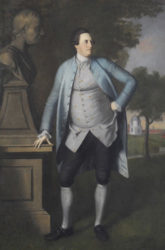
William Paca by Charles Willson Peale MSA SC 4680-10-0083 Source Maryland State House
“Even though he had many reservations, he voted in 1788 to approve the Constitution. He advocated 28 amendments to the Constitution, including those on freedom of religion, freedom of the press, and protection against judicial tyranny, and many of his proposed amendments became a part of the Bill of Rights.” [Source: The Society of the Descendants of the Signers of the Declaration.]
He was twice married, but both wives died after childbirth, and Paca also fathered two children out of wedlock, one to a mixed race woman while serving in Philadelphia, according to the Society of the Descendants. He was later appointed a federal judge by President Washington, and was in that post at his death in 1799 at age 58. YES
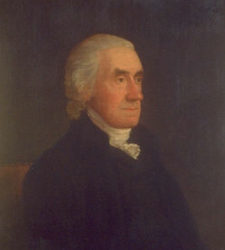
Robert Treat Paine (Courtesy: Massachusetts Historical Society, Boston, Massachusetts)
–Robert Treat Paine (Massachusetts) Overshadowed by two Adamses and Hancock, he was a minister turned attorney, 45-years-old at the signing, who had also been a sea captain on a whaler.
“In 1754, as Captain of the Seaflower, he led a whaling expedition from Cape Cod to Greenland and left behind what is believed to be the earliest illustrated log of a whaling venture kept by an American.” [Source: Society of the Descendants of the Signers]
He is perhaps best known as one of the prosecutors in the 1770 trial of the British soldiers charged in “Boston Massacre.” His friend and fellow delegate John Adams had served successfully as their defender. In 1780, he was among the founders of the American Academy of Arts and Sciences, one of the first American groups dedicated to expanding scientific knowledge and learning. After the war, he remained active in Massachusetts politics, becoming the state’s Attorney General, and was named a state judge by John Hancock until his retirement in 1804 due to deafness. He died in 1814 at age 83. NO
–John Penn (North Carolina) A wealthy planter’s son who taught himself to read and write, he was a 36-year-old attorney at the signing. He remained in Congress and was one of the signers who also signed the first American constitution, the Articles of Confederation. He retired to private law practice and died in 1788 at age 48. YES
–George Read ( Delaware) Among the conservative delegates, he was a 42-year-old lawyer at the time of the signing but had voted against independence on July 2.He served in state offices until ill health forced his resignation. But he returned to Philadelphia to take part in the Constitutional convention and was leading voice for small states’ rights and led the ratification forces in Delaware, the first state to ratify the Constitution. Elected to the Senate, he resigned to take a judgeship in Delaware before his death in 1798 at age 65. YES
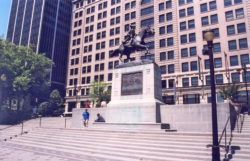
Statue of Caesar Rodney on his ride-Rodney Square Wilmington, DE (Public Domain)
–Caesar Rodney (Delaware) Another self educated attorney, son of a planter, he was 47 at the signing. Rodney exemplifies the Great Contradiction of the Declaration, as he had earlier introduced legislation against the foreign slave trade:
“In 1766, as the Speaker of the [Delaware] Assembly, he introduced a bill to prohibit the importation of slaves into Delaware. At this time he was living in Byfield, a plantation of 1,000 acres, and owned 200 slaves. It is clear that he was pondering questions of the Colony’s and Mankind’s liberty and freedom. Indeed, at his death fourteen years later, he directed that all his slaves should be freed then, or shortly thereafter.” [Source: The Society of the Descendants]
He is perhaps best known for an 80-mile ride in a storm to break a deadlock that put Delaware in the Independence column –which cost him favor with conservatives in his home state. He later wrote in a letter:
“I arrived in Congress (tho detained by thunder and rain) time enough to give my voice in the matter of independence . . . We have now got through the whole of the declaration and ordered it to be printed so that you will soon have the pleasure of seeing it.” [Source: The Society of the Descendants]
One of the three bachelor signers (Francis Lee and Thomas Lynch were the others), he remained in the Congress until he became Delaware’s state president. A cancerous growth on his face was untreated and he covered it with a silk veil, worn for a decade before his death in 1784 at age 55. YES

June 26, 2021
Whatever Became of 56 Signers? (7th in series)
(Updated 6/26/2021)
Part 7 in a series that begins here. Read the other entries here in my blog category.
As the nation examines the role slavery played in its history, it is important to recognize that slavery was an issue in 1776. Among the men who signed the Declaration, at least forty of them enslaved people or took part in the slave trade. “YES” following the entry means the Signer enslaved people; “No” means he did not.
…We mutually pledge to each other our Lives, our Fortunes , and our Sacred Honor.

The Grand Flag of the Union, first raised in 1775 and by George Washington in early 1776 in Boston. The Stars and Stripes did not become the “American flag” until June 14, 1777. (Author photo © Kenneth C. Davis)
A tavern owner’s son. Two of America’s wealthiest men –both named Morris. And the first to die. The next five signers in this series.
-Thomas McKean (Delaware) Son of a Pennsylvania farmer-tavern owner, McKean was a self educated, 42-year-old attorney turned politician at the time of the signing (although he did not sign in 1776).
in 1768 he was elected to the American Philosophical Society, a distinguished intellectual society founded by Benjamin Franklin. In 1769 McKean became a trustee of the Academy of Newark, the successor to Allison’s school at New London. He received honorary degrees from Princeton in 1781, Dartmouth in 1782 and Pennsylvania in 1785. Source: The Society of Descendants of the Signers of the Declaration.
A vigorous patriot, he held offices in both his native Pennsylvania and Delaware and was a key supporter of the Declaration. When another delegate from Delaware was absent and the state might vote against independence, McKean sent a horse and rider to collect fellow delegate Caesar Rodney and bring him back to vote — an 80-mile ride in a storm. There is some dispute about when he actually signed, but it was after January 1777.
McKean and his family were pursued by the British but never captured. A vocal advocate of the Constitution, he served in many state posts, including governor of Pennsylvania, and prospered after the war. He died in 1817 at age 83. YES
–Arthur Middleton (South Carolina) A 34-year-old plantation owner at the signing, he replaced his father –thought too conservative — in Congress. Educated in England, he became active in patriot politics. One of the few delegates to serve in the wartime militia, he was captured in Charleston in 1780, along with Thomas Heyward (Post #4) and Rutledge, two other South Carolina signers. Although his home had been destroyed he was released by the British and returned to Congress in 1781. After the war he returned to his plantation where he died at age 44 in 1787. YES
–Lewis Morris (New York) Another of the wealthy sons of prominent New York families in the state’s delegation, Morris was a 50-year-old land owner with large holdings in what is now the Bronx in New York City. Although his home was assaulted by British troops during the war, it was attacked and severely damaged because of its value, not because he was a signer. Morris led troops of the militia during the vote in July, but then led the New York delegation in later signing the Declaration, making it unanimous. Morris rebuilt the family home and land holdings after the war and was a leader with Alexander Hamilton in ratification of the Constitution. He died in 1798, aged 71 and his former plantation is known today as the Morrisania section of the Bronx. YES
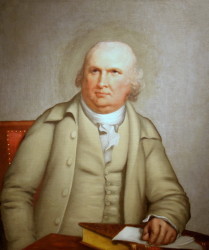
Oil painting of Robert Morris by Robert Pine (c. 1785)
–Robert Morris (Pennsylvania) (No relation to Lewis Morris above.) One of the wealthiest individuals in America, he was a 42-year-old Philadelphia merchant and speculator when he signed. Born in Liverpool, he had come to America and made a fortune as a merchant, becoming the “Financier of the Revolution.” Accused of profiteering during the war, he was attacked in the Philadelphia home of fellow signer James Wilson. A delegate to the Constitutional Convention in 1787, he declined to serve as Washington’s secretary of Treasury, recommending Alexander Hamilton instead. He later became a Senator. But he lost his fortune through land speculation and was bankrupted and put in debtor’s prison. He died in poverty and relative obscurity in 1806, aged 72. YES
–John Morton (Pennsylvania) A farm boy turned surveyor, he was 52-years-old at the time of the signing. He has two key distinctions: his vote pushed Pennsylvania into the pro-independence camp and then he was first signer to die. He fell ill with tuberculosis in 1777 and died at about age 52, leaving his farm and enslaved people to his wife and children who had to flee from a British attack. YES
June 25, 2021
Whatever Became of 56 Signers? (6th in a series)
[Post updated 6/25/2021]
Now that Juneteenth has become a national holiday observed as the other “Independence Day,” it is time to look back on the first Independence Day –July 4th, 1776. As the nation is going through an examination of the role slavery played in American History, it is important to recognize its role at Philadelphia. You cannot teach American History without acknowledging the role slavery played. And talking about the men who signed the Declaration is one way to do that.
This is the sixth in a series of posts about the men who signed the Declaration of Independence and what became of them. The series begins here.
…We mutually pledge to each other our Lives, our Fortunes , and our Sacred Honor.

The Grand Flag of the Union, first raised in 1775 and by George Washington in early 1776 in Boston. The Stars and Stripes did not become the “American flag” until June 14, 1777. (Author photo © Kenneth C. Davis)
The Yes after a named means the Signer enslaved people; No means he did not.
Wealthy planters, and a couple of very wealthy New York merchants.
-Richard Henry Lee (Virginia) A 41-year-old planter from a prominent Virginia family –his younger brother Francis Lightfoot (See previous post) was also there– Lee deserves more acclaim than he usually gets. A “great orator,” said John Adams, Lee introduced the resolution for independence. He left Congress to attend to state business in Virginia and didn’t vote for the resolution or the Declaration, which he signed later in the summer of 1776.
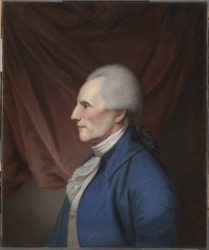
Richard Henry Lee National Portrait Gallery, Smithsonian Institution; gift of Duncan Lee and his son, Gavin Dunbar Lee
He was one of the few signers to actually serve with a Virginia militia unit. He remained in politics after the war, becoming a vocal opponent of the Constitution but an advocate for the Bill of Rights. He was elected to the U.S. Senate but resigned in ill health and died at age 62 in 1794. YES
–Francis Lewis (New York) A native of Wales, he was a 63-year-old merchant at the time of the signing, a key supporter of George Washington, but was instructed not to vote for the Declaration by New York. He then signed in August. During the war, his wife was imprisoned by the British and died shortly after her release, leaving Lewis grief-stricken. He died in 1802 at age 89, was buried in an unmarked grave at Manhattan’s Trinity Church, and now, curious New Yorkers will know why there is a Francis Lewis Boulevard in Queens. YES
–Philip Livingston (New York) The 60-year-old member of one of New York’s wealthiest families, with an estate of 160,000 acres on the Hudson River, he was a merchant who favored the patriot cause. But like many New Yorkers, he was more moderate and cautious about declaring independence and was absent when the entire delegation abstained from the vote. He signed in August. (Robert Livingston, a cousin and member of the Declaration draft committee, was also absent from the vote and never signed the Declaration).
“General Washington and his officers met at Philip’s residence in Brooklyn Heights after their defeat in the battle of Long Island, and decided to evacuate the island. The British subsequently used Philip’s Duke Street home as a barracks, and his Brooklyn Heights residence as a Royal Navy hospital. As the British occupied New York City, Philip and his family fled to Kingston, NY where he maintained another residence. Later, the British burned the city of Kingston to the ground as they did Robert R. Livingston’s mansion, Clermont, across the Hudson River.” (Source: Society of the Descendants of the Signers of the Declaration of Independence
Although he sold some of his property to support the war effort, his family continued to amass large land holdings in upstate New York. In poor health, he died at age 62 in 1778, when Congress was forced to evacuate Philadelphia and move to York, Pa. YES
–Thomas Lynch, Jr. (South Carolina) At 27, the second youngest signer (after Edward Rutledge also of South Carolina), he was lawyer and the son of a delegate. When his father, a wealthy planter, suffered a stroke, the younger Lynch was sent to Congress. (His father was unable to vote or sign.) Both left for home in poor health and the elder Lynch died en route.
Lynch Jr. and his wife later sailed for the West Indies in the hope of regaining his health but both died at sea in 1779 when their ship was lost in a storm. Among the youngest signers, he was the youngest signer to die at age 30. YES
June 24, 2021
Whatever Became of 56 Signers? (5th in a series)
[Post updated 6/23/2021]
Now that Juneteenth has become a national holiday observed as the other “Independence Day,” it is time to look back on the first Independence Day –July 4th, 1776. As the nation is going through an examination of the role slavery played in American History, it is important to recognize its role at Philadelphia. You cannot teach American History without acknowledging the role slavery played. And talking about the men who signed the Declaration is one way to do that.
This is the fifth in a series of posts about the men who signed the Declaration of Independence and what became of them. The series begins here.
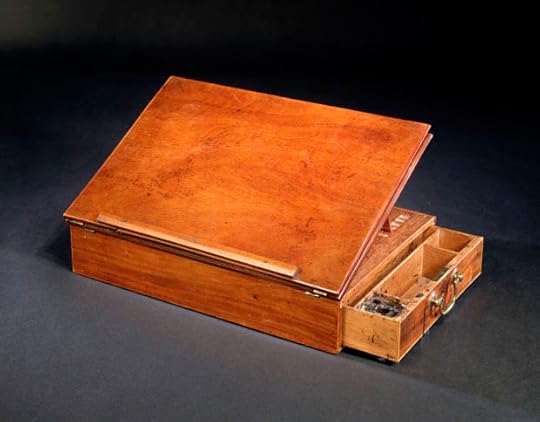
Jefferson’s Desk on which he drafted the Declaration (Image: American Museum of History/Smithsonian)
Slave trader turned early abolitionist. Flag designer. “First President.” Member of a Virginia dynasty. And the Author.
-Stephen Hopkins (Rhode Island) Second oldest delegate after Franklin, Hopkins was 69-years-old at the signing. A merchant, he had been Rhode Island’s colonial governor but was an outspoken advocate of independence having written a document entitled, The Rights of the Colonies Examined in 1764.
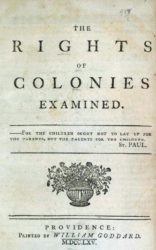
“Rights of the Colonies Examined” (1765 :Source Wikimedia Commons
A partner of the wealthy Brown brothers who were involved in the slave trade –Newport was a key northern slavery port– he enslaved several people. The role of Stephen Hopkins, his brother Esek -captain of a slave ship- and the Brown brothers as enslavers and the founding of what became Brown University is detailed in a report commissioned by Brown called Slavery and Justice.
But in 1774, he secured passage of law prohibiting the slave trade in Rhode Island, one of the first anti-slavery laws in the colonies and he began freeing some but not all of the people he enslaved. In ill health, he retired from politics and public life and died in 1785 at age 78. YES
-Francis Hopkinson (New Jersey) Like Franklin and Jefferson, Hopkinson was a man of many talents, a 38-year-old attorney and musician at the time of the signing. He was the son of the founder –with Franklin– of the University of Pennsylvania and was among the school’s first graduates. Though long overlooked, he has more recently gotten his due as the designer of the “Stars and Stripes.” The claim is based on Hopkinson submitting a bill for his work on the flag and requesting “a quarter cask of the public wine” in payment. He was already on the Congressional payroll so the request was refused. While his home was ransacked during the war, he emerged relatively unscathed and later became a Federal judge before his death in 1791 at 53. YES
-Samuel Huntington (Connecticut) An apprenticed barrel-maker who became a successful attorney, he was a 45-year-old politician at the time of the signing, having resigned his post as “King’s Attorney.” His true distinction is serving as “President of the United States in Congress Assembled” when the Articles of Confederation were adopted –making him the “First President,” sort of. Others have staked that claim as well. He served in a variety of national and state posts, including being the sitting governor of Connecticut at his death in 1796 at age 64. NO
–Thomas Jefferson (Virginia) 33-year-old planter, scientist, writer, and lawyer. You know most of the rest. But Jefferson’s wartime service as Virginia’s governor is sometimes overlooked. In 1781, he was Virginia’s governor when the British attacked the state, including forces led by Benedict Arnold. Jefferson fled and was later investigated by the state legislature but no charges were filed. People enslaved by Jefferson were captured by the British and were being held in Yorktown during the siege in September-October 1781 and were later returned to Jefferson by George Washington.
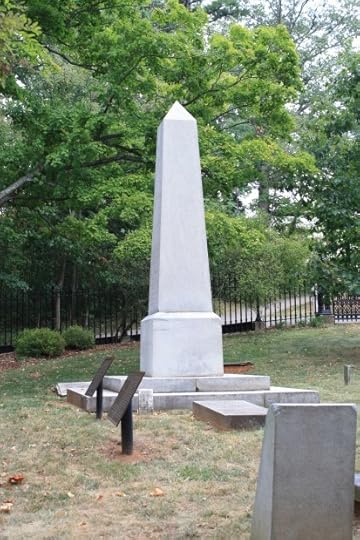
Thomas Jefferson’s Grave Marker at Monticello (Author photo)
He died, like John Adams, on the 50th anniversary of the adoption –July 4, 1826. See the Monticello site for more information. YES
–Francis Lightfoot Lee (Virginia) A member of the state’s prominent planter family, he was 41 years old at the signing, the quiet brother of Richard Henry Lee, who offered the first resolution calling for independence in June 1776. After the war, he was a prominent advocate of the new Constitution, unlike his more visible older brother. He left the national scene and died at age 62 in 1797. YES
Whatever Became of 56 Signers (5th in a series)
[Post updated 6/23/2021]
Now that Juneteenth has become a national holiday observed as the other “Independence Day,” it is time to look back on the first Independence Day –July 4th, 1776. As the nation is going through an examination of the role slavery played in American History, it is important to recognize its role at Philadelphia. You cannot teach American History without acknowledging the role slavery played. And talking about the men who signed the Declaration is one way to do that.
This is the fifth in a series of posts about the men who signed the Declaration of Independence and what became of them. The series begins here.

Jefferson’s Desk on which he drafted the Declaration (Image: American Museum of History/Smithsonian)
Slave trader turned early abolitionist. Flag designer. “First President.” Member of a Virginia dynasty. And the Author.
-Stephen Hopkins (Rhode Island) Second oldest delegate after Franklin, Hopkins was 69-years-old at the signing. A merchant, he had been Rhode Island’s colonial governor but was an outspoken advocate of independence having written a document entitled, The Rights of the Colonies Examined in 1764.

“Rights of the Colonies Examined” (1765 :Source Wikimedia Commons
A partner of the wealthy Brown brothers who were involved in the slave trade –Newport was a key northern slavery port– he enslaved several people. The role of Stephen Hopkins, his brother Esek -captain of a slave ship- and the Brown brothers as enslavers and the founding of what became Brown University is detailed in a report commissioned by Brown called Slavery and Justice.
But in 1774, he secured passage of law prohibiting the slave trade in Rhode Island, one of the first anti-slavery laws in the colonies and he began freeing some but not all of the people he enslaved. In ill health, he retired from politics and public life and died in 1785 at age 78. YES
-Francis Hopkinson (New Jersey) Like Franklin and Jefferson, Hopkinson was a man of many talents, a 38-year-old attorney and musician at the time of the signing. He was the son of the founder –with Franklin– of the University of Pennsylvania and was among the school’s first graduates. Though long overlooked, he has more recently gotten his due as the designer of the “Stars and Stripes.” The claim is based on Hopkinson submitting a bill for his work on the flag and requesting “a quarter cask of the public wine” in payment. He was already on the Congressional payroll so the request was refused. While his home was ransacked during the war, he emerged relatively unscathed and later became a Federal judge before his death in 1791 at 53. YES
-Samuel Huntington (Connecticut) An apprenticed barrel-maker who became a successful attorney, he was a 45-year-old politician at the time of the signing, having resigned his post as “King’s Attorney.” His true distinction is serving as “President of the United States in Congress Assembled” when the Articles of Confederation were adopted –making him the “First President,” sort of. Others have staked that claim as well. He served in a variety of national and state posts, including being the sitting governor of Connecticut at his death in 1796 at age 64. NO
–Thomas Jefferson (Virginia) 33-year-old planter, scientist, writer, and lawyer. You know most of the rest. But Jefferson’s wartime service as Virginia’s governor is sometimes overlooked. In 1781, he was Virginia’s governor when the British attacked the state, including forces led by Benedict Arnold. Jefferson fled and was later investigated by the state legislature but no charges were filed. People enslaved by Jefferson were captured by the British and were being held in Yorktown during the siege in September-October 1781 and were later returned to Jefferson by George Washington.

Thomas Jefferson’s Grave Marker at Monticello (Author photo)
He died, like John Adams, on the 50th anniversary of the adoption –July 4, 1826. See the Monticello site for more information. YES
–Francis Lightfoot Lee (Virginia) A member of the state’s prominent planter family, he was 41 years old at the signing, the quiet brother of Richard Henry Lee, who offered the first resolution calling for independence in June 1776. After the war, he was a prominent advocate of the new Constitution, unlike his more visible older brother. He left the national scene and died at age 62 in 1797. YES
June 23, 2021
Whatever Became of 56 Signers? (4th in a series)
[Post revised 6/23/2021]
…We mutually pledge to each other our Lives, our Fortunes, and our Sacred Honor.
This is the fourth in a series of posts about the men who signed the Declaration of Independence and what became of them. The series begins here.
Or follow the series here in the blog.
Now that Juneteenth has become a national holiday observed as the other “Independence Day,” it is time to look back on the first Independence Day –July 4th, 1776. As the nation is going through an examination of the role slavery played in American History, it is important to recognize its role at Philadelphia.
You cannot teach American History without acknowledging the role slavery played. And talking about the men who signed the Declaration is one way to do that. Slavery existed in all thirteen of the future states and at least 40 of the 56 signers enslaved people or were involved in the slave trade. One focus of the series is to show which of these men enslaved people or otherwise participated in the slave trade.
Father and great-grandfather of presidents. A simple farmer. A Quaker workaholic. More lawyers. The next five signers, in alphabetical order. (“Yes” following the entry means slaveholder; “No” means not a slaveholder.)
-Benjamin Harrison V (Virginia) A member of the Virginia aristocracy, he was a well-to-do planter, around 50-years-old at the the signing.
On June 7, 1776, Benjamin Harrison was chosen to introduce fellow Virginian Richard Henry Lee whose resolution called for independence from England. He was selected to read Jefferson’s draft of the Declaration of Independence to the assembled delegates on July 1… [Source: Berkeley Plantation]
Besides his role in the July 2 and 4 votes in Philadelphia, he is mostly distinguished as being the father of 9th president William Henry Harrison and great-grandfather of namesake Benjamin Harrison, the 23rd president.
Although his famed Berkeley Plantation on the James River was attacked and partially burned by British forces led by the traitor Benedict Arnold, it clearly survived the war. So did Harrison, who went on to serve three terms as governor of Virginia before his death in 1791 at age 65. YES
-John Hart (New Jersey) Described as a well-meaning “Jersey” farmer with little education, Hart was a 65-year-old planter at the time of the signing, and devoted to the patriot cause. Although supposedly hounded by the British during the war, he was later able to entertain General Washington and allow 12,000 troops to camp in his fields in 1778. He died of kidney stones in 1779, aged 68. YES
–Joseph Hewes (North Carolina) Born in New Jersey, he moved to North Carolina and was a 46-year-old Quaker merchant at the signing. At first a reluctant patriot, he broke with the Quakers over the possibility of a violent rebellion and was considered a key influence in Congress by John Adams. His shipping experience was significant enough for him to be described as the first “secretary of the Navy,” responsible for getting his friend John Paul Jones a commission. Working relentlessly for the Congress, Hewes fell sick and died in 1779 at age 49 and was deeply mourned by his Congressional colleagues. YES
-Thomas Heyward, Jr. (South Carolina) Son of a wealthy planter, he was a 30-year-old lawyer at the signing. Heyward counts as one of the few signers actually captured by the British, who then took his enslaved people, apparently shipping them to bondage in the West Indies. Initially paroled –released under an agreement– he was later taken aboard a prison ship and held in St. Augustine, Florida under a form of house arrest until released in a prisoner exchange. While a hostage, he is credited with writing verses to a song called “God Save the Thirteen States.” He dabbled in politics after the war, but focused on rebuilding his family plantation where he died at 63 in 1809. YES
-William Hooper (North Carolina) Born in Boston, he was a 34-year-old attorney who had moved South at the signing. He missed the key July vote but returned to sign the Declaration in August. Hooper was one of the signers who suffered losses during the war when the British invaders evacuating the Wilmington, North Carolina area destroyed his home. He later pressed for ratification of the Constitution but lacked popularity in his adopted state and, suffering from a variety of illnesses, including malaria, died in 1790 at age 48. YES
June 22, 2021
Whatever Became Of…56 Signers? (3d in series)
[Post revised June 22, 2021]
Now that Juneteenth has become a national holiday observed as the other “Independence Day,” it is time to look back on the first Independence Day –July 4th, 1776. As the nation is going through an examination of the role slavery played in American History, it is important to recognize its role at Philadelphia. You cannot teach American History without acknowledging the role slavery played. And talking about the men who signed the Declaration is one way to do that.
This is the third in a series of posts about the men who signed the Declaration of Independence and what became of them. The series begins here.
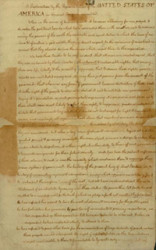
Fair Copy of the Draft of the Declaration of Independence (Source New York Public Library)
A printer, a politician with a notable name, a duelist, a Connecticut Yankee, and the most famous signature in U.S. history.
A “Yes” after their names means they enslaved people; “No” means they did not.
-Benjamin Franklin (Pennsylvania) America’s most famous man in 1776, Franklin was 70 years old at the time of the signing. Printer, publisher, writer, scientist, diplomat, philosopher –he was the embodiment of the Enlightenment ideal. A member of the draft committee that produced the Declaration, Franklin was a central figure in the independence vote and then helped the war effort by winning crucial French support for the America cause.

National Portrait Gallery, Smithsonian Institution; gift of the Morris and Gwendolyn Cafritz Foundation https://npg.si.edu/object/npg_NPG.87....
But he lost no Fortune, reportedly tripling his wealth during the conflict. Franklin returned to the scene of the Declaration’s passage in 1787 to help draft the Constitution. When he died at age 84 in 1790, his funeral was attended by a crowd equal to Philadelphia’s population at the time. Read more on Franklin at this National Park Service site. YES
–Elbridge Gerry (Massachusetts) A 32-year-old merchant from Marblehead, Gerry (pronounced with a hard G like Gary) is much more famous for later dividing Massachusetts into oddly-shaped voting districts as the state’s governor. A cartoonist compared the districts to a salamander and the word “gerry-mandering” was born.

“The Gerry-mander,” political cartoon by Elkanah Tisdale, Boston Gazette, 1812. © North Wind Picture Archives via Britannica https://www.britannica.com/topic/gerr...
Though he voted for independence, Gerry was not present to sign in August, signing later in the fall of 1776. He profited from the war and later joined the Massachusetts delegation to the Constitutional convention in 1787, although he refused to sign the Constitution. He became James Madison’s second vice president in 1813, but died in office in 1814 at age 70. NO
–Button Gwinnett (Georgia) An English-born plantation owner and merchant, he was 41-years-old at the time of the signing. And didn’t last much longer. A political argument with a Georgia general led to a duel in which Gwinnett was mortally wounded. He died in 1777 at age 42, the second of the signers to die. (John Morton of Pennsylvania was first.) YES
–Lyman Hall (Georgia) A Connecticut Yankee Congregational minister and physician transplanted to Georgia plantation owner, Hall was 52 years old at the signing. A vocal patriot when Georgia was far more hesitant about independence, he first came to Philadelphia as a nonvoting delegate. Hall’s plantation was destroyed during the war during the punishing British campaigns in the South. He later served as Georgia’s governor, dying at age 66 in 1790. YES
–John Hancock (Massachusetts) Born into a poor parson’s family in Lexington (National Parks Service site), Hancock was sent to live with a wealthy uncle when his father died. He inherited his uncle’s shipping business and was one of America’s wealthiest men by the time he was thirty. A patriot leader in Boston, it was Hancock and Samuel Adams who the British sought to capture on that April 1775 night when the war began.

Cropped from Image:Us_declaration_independence.jpg and enhanced slightly by Tim Packer Image:John_Hancock_Signature_DOI.PNG. Source: Wikimedia Commons
President of the Continental Congress when independence was declared, he was 39 at the time of the signing. The out-sized signature on the document cemented his fame in American lore. Elected Governor of Massachusetts in 1780,
Hancock lived a conspicuously opulent life in his mansion crowning Beacon Hill. The citizenry still had weapons and were accustomed to fighting the taxes of remote governments. Recognizing the stirrings of revolution and suffering from reoccurring gout, Hancock resigned the governorship until the resistance, which took the form of Shay’s Rebellion, was put down.
(Source: Commonwealth of Massachusetts)
After the war,
Governor Hancock continued to be reelected annually with victory margins frequently well above eighty percent. He died in office in 1793 and was succeeded by his friend, Lieutenant Governor Samuel Adams. (Source: Commonwealth of Massachusetts)
YES
June 21, 2021
Whatever Became Of…56 Signers? (2d in a series)
(Post revised and updated 6-21-2021) Second in a series that begins here.
Now that Juneteenth has become a national holiday observed as the other “Independence Day,” it is time to look back on the first Independence Day –July 4th, 1776. As the nation is going through an examination of the role slavery played in American History, it is important to recognize its role at Philadelphia. You cannot teach American History without acknowledging the role slavery played. And talking about the men who signed the Declaration is one way to do that.
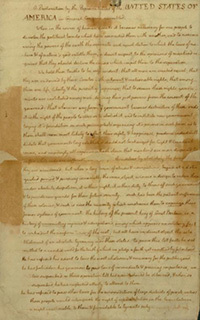
Fair Copy of the Draft of the Declaration of Independence (Source New York Public Library)
…We mutually pledge to each other our Lives, our Fortunes , and our Sacred Honor.
(A “YES” denotes an enslaver or slave trader; “NO” means the person did not enslave people.)
Here are the next five Signers of the Declaration, continuing in alphabetical order:
–Samuel Chase (Maryland) A 35-year-old attorney, Chase is among those signers who did not vote on July 4; he signed the later printed version in August. Accused of wartime profiteering but never tried or convicted, he later went broke from business speculating and settled into law practice. President George Washington appointed him to the Supreme Court, and Chase became the first justice to be impeached –although he was acquitted in 1805 by the Senate in a trial presided over by Vice President Aaron Burr.
The failure of the Senate to convict allowed Chase to return to the Supreme Court and serve 6 more years as an associate justice. More importantly, the acquittal deterred the House of Representatives from using impeachment as a partisan political tool.
Read more about Chase’s impeachment and acquittal.
Chase returned to the Supreme Court and died of a heart attack in 1811 at age 70. YES Learn more about Impeachment history here.
-Abraham Clark (New Jersey) An attorney, 50 years old at the signing, Clark had two sons who were captured and imprisoned during the war; one on the notorious British prison ship Jersey and the other in a New York jail cell. Clark served in Congress on and off and opposed the Constitution’s ratification until the Bill of Rights was added. He died in 1794 at age 68. YES
–George Clymer (Pennsylvania) A 37-year-old merchant the time of the signing, Clymer was a well-heeled patriot leader who helped fund the American war effort. He was also elected to Congress after the July 2 independence vote, signing the Declaration on August 2. He belongs to an elite group who signed both the Declaration and the Constitution. (The others were Roger Sherman of Conn,; George Read of Del.; and Benjamin Franklin, Robert Morris and James Wilson, all of PA.) He continued to prosper after the war and died in 1813 at age 74. NO
-William Ellery (Rhode Island) A modestly successful merchant turned attorney, aged 48 at the signing, Ellery replaced an earlier Rhode Island delegate who died of smallpox in Philadelphia. (Smallpox killed more Americans than the war did during the Revolution.) A dedicated member of Congress during the war years, Ellery saw his home burned by the British although it is thought unlikely they knew it was the home of a Signer. An abolitionist, he was rewarded after the war by President Washington with the lucrative post of collector for the port of Newport which he held for three decades. He died in 1829, aged 92, second in longevity among signers after Carroll. NO
-William Floyd (New York) At the signing, a 41-year-old land speculator born on Long Island, New York, Floyd abstained from the July 2 independence vote with the rest of the New York delegation. But he is thought to be the first New Yorker to sign the Declaration on August 2. Reports that his home on Fire Island was destroyed by the British were exaggerated, although it was used as a stable and barracks by the occupying Redcoats. (It is now part of a Fire Island National Park.) Floyd served in the first Congress before moving to western New York where he owned massive land tracts and where he died at age 86 in 1821. YES
In the Shadow of Liberty: The Hidden History of Slavery, Four Presidents, and Five Black Lives




